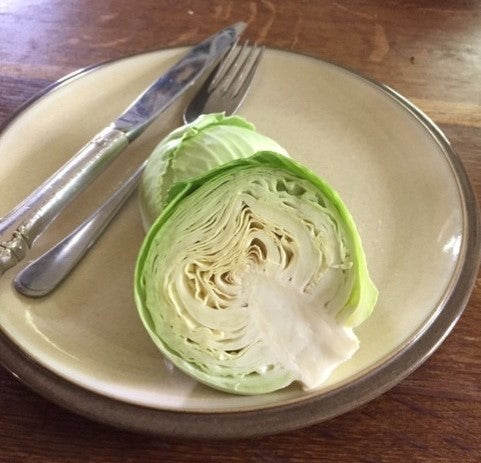
Baseball Cabbages
Over the last few years, we've been selecting cabbages that were originally part of a series of cabbages known as The Baseball Series, bred here in Canada in the 1960's, and now the last few remaining seeds are stored at the Plant Gene Resource of Canada.
This is where we obtained the seed to try and revive it and bring back the cabbage to all of you. We met (by phone and email) Axel through the PGRC, and Axel wrote the article below about the project and the Gene Bank. If you're interested in plant breeding and different varieties, check it out!
______________
In recent years, many Canadians have re-discovered home gardening. Many Canadians have additionally noticed that there are not only a great variety of vegetable species, but that there is also a great diversity within many of these species. A striking example is the diversity that exists within the botanical species Brassica oleracea which includes very distinct types such as cauliflower, broccoli, cabbage, kale, brussels sprouts, and kohlrabi; some of them with very distinct sub-types. Such intra-species diversity, which can be striking and very noticeable in some botanical species, is also referred to as genetic diversity. In many other species such genetic diversity is less obvious but still exists. Genebanks, such as the Plant Gene Resources of Canada (PGRC), have the task to preserve not only the obvious but also the mostly very subtle genetic diversity in cultivated plants and their crop wild relatives (PGRC 2025).
For that reason, the PGRC, located at Agriculture and Agri-Food Canada’s Saskatoon Research and Development Centre, houses large collections of important agricultural crops such as oat, wheat and barley, which make up about 75% of the 120,000 seed samples (accessions) preserved there. From 2002 to 2024, a total of 152,885 samples were shipped by PGRC serving 2227 clients in 71 countries. Canadian clients received 82% of the seed samples. Each distributed sample package contains about 100 seeds, and access is provided free of charge. As a government institution, the PGRC cannot act as a seed source for home gardeners or compete with private seed-selling businesses. The purpose of PGRC is to conserve the genetic diversity of crop species relevant to Canada and to provide it for research, breeding and education. The greatest challenge for PGRC is not shipping seeds, but rather ensuring the viability of these preserved seeds by rejuvenating them from time to time by planting them in the field or greenhouses where each species has different requirements for producing seeds.
PGRC also curates several vegetables among its seed collections, including a total of 71 different cabbages, mostly cultivars, which is not a lot given the diversity and relevance of this vegetable for Canada. Growing cabbage for seed has challenges. Firstly, cabbage is biennial; the flowering occurs in the second year and the plants need to be stored and protected from hard frosts over winter. Secondly, cabbage is outcrossing, requiring insects for pollination. And thirdly, if you grow more than one cabbage cultivar, you need to isolate them from each other during flowering by tenting or distance to avoid interbreeding. This makes cabbage a demanding crop for PGRC which has caused delays in achieving the required seed increases and some stored seed lots at PGRC may be no longer be viable. Breeding programs for cabbages and other vegetables that existed in Canada during most of the 20th century have since been discontinued. Today, Canada depends on breeding programs in other countries for cabbages along with many other vegetables.
The history of ‘Pee Wee” is quite unique. It belongs to a series of three dwarf cabbages bred in the 1960s at what is now the Agriculture and Agri-Food Canada’s Morden Research and Development Centre (formerly called the Morden Experimental Farm). The breeder, Charles Walkof (1910-1984) explained in a publication from 1964 that three cabbage cultivars with smaller heads were bred in Morden. The smaller heads had advantages: (1) they are early producing; (2) the smaller head can be cooked and consumed entirely by a family during one meal, avoiding storage of a partly used head that may go to waste; (3) a smaller head can be boiled as an entire head without shredding, hence preserving the flavour better and resulting in a rich flavour similar to that of brussels sprouts; (4) after harvesting the first cabbage head, a new heads can emerge from the trunk allowing for harvesting until September. These breeding objectives were focused on addressing the needs of home gardeners or small farmers, rather than for industrial production. Walkof released three cabbages in 1966 with a head size similar to a baseball and named them ‘Pee Wee’, ‘Little Leaguer’ and ‘Junior’, with the latter two having slightly larger heads of the size of a softball (Walkof 1967). The weight of the heads ranged from ½ to 1½ pounds per head. This cabbage triplet was hence named the “baseball” series of dwarf cabbage varieties. All three cultivars have been preserved as accessions by PGRC. The national genebank of the United States also lists these three Canadian cabbage cultivars.

Important activities for ensuring the preservation and utilization of genetic diversity have emerged in Canada during the last 20 years. Kitchen Table Seed House, a small seed growing operation from Wolfe Island, Ontario that specializes in open-pollinated varieties, approached PGRC in 2022 to obtain the very special ‘Pee Wee’ cabbage cultivar.
The PGRC was able to supply seeds from ‘Pee Wee’ accession number CN 33074 to Kitchen Table Seed House. The seeds had been stored for nearly 50 years, since 1974. They could only grow 5 plants from the old and poorly germinating seeds, but the revival was successful. They managed to get the 5 plant stalks to overwinter and successfully make seed the next season, and were able to grow out 300 cabbages in 2024. The head sizes were variable, from ‘Little leaguer’ and ‘Junior’ to ‘Pee-wee’, with some heads as large as standard varieties. They also noticed about 5% were cone-shaped heads, and a few with purpling outer leaves. These observations indicated that the seeds provided by PGRC were a segregating population and re-selection to obtain the desired ‘Pee Wee’ appearance was required. Kitchen Table sold many of the small heads to a local restaurant and agreed with the chef that the eating quality and flavour was superb. The recorded days to maturity for the first flush of ready heads was 55 days, and the stalks kept producing new, smaller cabbage heads all throughout the summer right up until hard frost while still maintaining great eating quality.


Kitchen Table is currently overwintering cabbage stalks selected to be small and round, as intended for ‘Pee-Wee’. Seeds will be collected next summer and heads grown out for fall harvest if all goes well. Kitchen Table is hoping to 'clean it up', and then re-introduce ‘Pee-wee’ to the market for gardeners.

Kitchen Table Seed House conducted a re-selection and was successful in re-selecting the genebank seeds to the original appearance of ‘Pee Wee’. They will also deposit some fresh seeds at PGRC, thus supporting the genebank. Thanks to these efforts gardeners will have again the opportunity to try this delicious cabbage. This small seed company provided the bridge from the long-term conservation at PGRC back to gardeners, farmers and consumers, who may enjoy the special features of this unique Canadian baseball cabbage series. This success may motivate others trying to grow seed to conduct their own selections, following the inspiration Charles Walkof had when he developed these dwarf cabbages.
This re-introduction of a historic cultivar for special use exemplifies how the PGRC seed genebank conducting ex situ conservation of crop plant diversity acts as a complement to the activities by small and farmer owned seed companies that practice on-farm conservation and breeding of otherwise neglected crops to enrich the diversity and nutrition of Canadians.
References
Walkof, C. 1964. Dwarf Cabbages bred for modern needs. Research for Farmers, winter 1964, Canada Department of Agriculture, Ottawa, p 3 and 15. https://publications.gc.ca/collections/collection_2021/aac-aafc/A49-2/A49-2-1964-1-eng.pdf.
Walkof, C. 1967. The “baseball” series of dwarf cabbage varieties. Canadian Journal of Plant Science 47, 119-120.
Plant Gene Resources of Canada 2025. PGRC Internet website. https://agriculture.canada.ca/en/science/collections/plant-gene-resources-canada.
By:
Axel Diederichsen1 and Annie Richard2
1 Plant Gene Resources of Canada, Agriculture and Agri-Food Canada, 107 Science Place, Saskatoon, SK, S7N 0X2, e-mail: axel.diederichsen@agr.gc.ca
2 Kitchen Table Seed House, #602 Highway 95, Wolfe Island, ON, K0H 2Y0, e-mail: info@kitchentableseedhouse.ca
